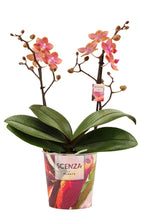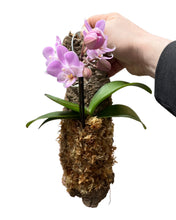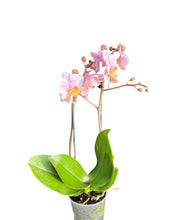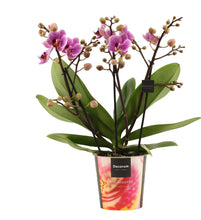Phalaenopsis are part of the Orchidaceae family and there are around 60 wild species in this genus, unfortunately many are threatened by habitat destruction and the logging industry as well as wild poaching.
Phalaenopsis are epiphytes, they use their chunky roots to keep them in place on host trees, they have a pendulous growth habit and don’t require the stakes (sometimes provided) for anything other than space saving.
The typical orchids you find in plant shops and other retailers are hybrids that have been bred over many years to cope well with the conditions in our homes. Phalaenopsis produce flat-faced flowers which emerge from arching stems. Miniature Phalaenopsis tend to produce more blooms as the flowers are smaller in size therefore taking less energy to produce.
Genus name is derived from the Ancient Greek word φαλαινα (phalaina) meaning 'a kind of moth' with the suffix -opsis meaning 'having the appearance of' or 'like'; this is in reference to the flower shape.
For more information on Epiphytes, read our blog here.
This Phalaenopsis is mounted on cork bark. Length of bark 20cm approx.
Light: Bright indirect light, meaning the plant sees the sun for 0-4 hours per day - this could be through trees or a translucent curtain, by reflected sun or through a skylight. 2-3 hours of direct sun is tolerable.
It is also worth considering how bright a particular spot is in winter vs summer.
Water: Water with lukewarm water when the moss is dry; if the plant is particularly dehydrated its' leaves will pucker.
Potting mix: These miniature Phalaenopsis have been mounted using sphagnum moss and pine bark.
Fertilising: Feed monthly using a well balanced fertiliser. You can further dilute fertiliser than the recommended amount but never add more.
Temperature: 18-26˚C. Provide winter night temperatures of 17-19˚C for 2-4 weeks to encourage new flower spikes.
Humidity: Although Phalaenopsis prefer higher humidity they do well to adapt to average home humidity.
Blooming information: When your flowers are spent you will be left with bare stems, they often turn yellow and this can continue down the stems. Usually the top of the flower spike won’t bloom again. Look at the stems and notice where the blooms were, if you look just below where the lowest flower was, you should see a dormant bud behind a small sheath, cut about 1 cm above that. Your orchid will now be putting energy into producing foliage, roots and secondary branches and plantlets.
The plant (foliage and roots) is growing during spring and summer, when the temperature drops in autumn/winter it begins to initiate growth of a flower spike. This can vary as commercial greenhouses use temperature to ensure plants are in bloom when purchased so just bear with your plant if it has a dormant year.
Phalaenopsis are non-toxic.







